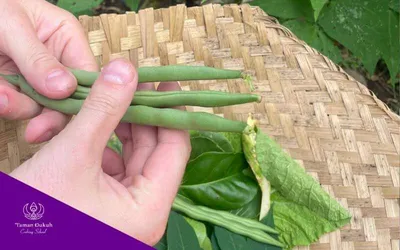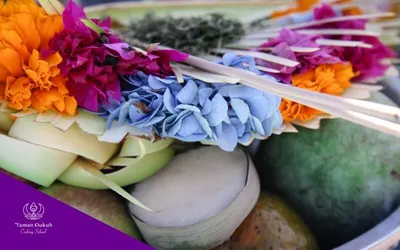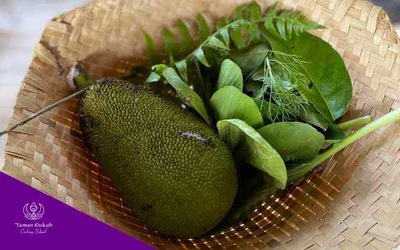Mastering Authentic Balinese Flavors: The Ancient Art of Sad Rasa & Culinary Harmony
Ever wondered what truly makes authentic Balinese dishes so uniquely “tasty and spectacular,” with a captivating depth of flavor that keeps you coming back for just one more bite?
The secret, cherished for centuries, lies in a beautiful, time-honored Balinese philosophy of meticulously balancing flavors. It’s a culinary art form, deeply rooted in ancient wisdom, that transforms simple Balinese spices and fresh ingredients into a harmonious symphony for your taste buds!
At Taman Dukuh, our “friendly, funny, and passionate” Balinese chefs absolutely love to share not just traditional Balinese recipes, but the very essence of how to “think like a Balinese cook.”
Join us as we explore the core tastes that define Balinese cuisine, particularly the profound concept of Sad Rasa (the six tastes), and how they are masterfully harmonized.
Understanding this is absolutely key to appreciating – and successfully recreating – that “authentic Balinese magic” you’ll discover in our Ubud cooking classes.
The Six Tastes of Bali (Sad Rasa): A Symphony of Flavors, Life’s Journey & Divine Blessings
At the very heart of Balinese flavor mastery is the ancient and profound concept of Sad Rasa, or the six fundamental tastes.
This philosophy, with deep roots in Ayurvedic tradition and prominently featured in Balinese Lontar manuscripts like “Kakawin Dharma Sawita” and “Dharma Caruban“, emphasizes that a balanced and harmonious meal should ideally incorporate all six tastes.
This isn’t just for achieving deliciousness; it’s also considered vital for overall well-being, digestive health, and spiritual satisfaction.
But there’s more to it than just culinary balance. Some Balinese believe these tastes are a divine blessing, bestowed upon the legendary Pandawa heroes from the Mahabharata epic:
- Yudhistira is said to have been blessed with
Asin(salty), manifested incakuh(kencur/lesser galangal). - Bima with
Sepat(astringent), found inisen(lengkuas/galangal). - Arjuna with
Pahit(bitter), embodied bykunir(kunyit/turmeric). - Nakula with
Pedas(spicy/pungent), represented byjae(jahe/ginger). - Sadewa with
Manis(sweet), which is seen inbawang merah&bawang putih(shallots & garlic). - And Drupadi, their revered wife, was blessed with
Asam(sour), perfectly captured byjeruk limau(lime).
This beautiful mythological connection underscores the sacredness of these flavors in Balinese food philosophy. As explored in our guide to the Sukla concept, these six tastes are also seen as formed from the essence of “Panca Maha Bhuta” (the five great elements that constitute life).
During important life-cycle ceremonies, these flavors are often ritually tasted, each carrying profound symbolic meaning for life’s journey.
Achieving harmony between these elements is crucial for a dish to be considered truly complete and nourishing in authentic Balinese culinary arts, reflecting a balance that extends to life itself.
Understanding “Sad Rasa” is fundamental to learning how to cook Balinese food authentically.
Let’s explore each of these essential tastes:
1. Manis (Sweet – Madhura): The Taste of Joy & Nourishment
Sweetness in Balinese cooking often comes from wholesome, natural sources like palm sugar (gula merah or gula aren), which offers a deep, rich, caramel-like complexity. Fresh tropical fruits and even aromatics like shallots and garlic (as per the Pandawa story) contribute to this profile.
Sweetness is used not just for desserts (jaje Bali), but to round out savory flavors and balance spiciness. Symbolically, Manis represents happiness and fulfillment.
2. Asam (Sour / Tart – Amla): The Taste of Awakening & Cleansing
Sourness provides a bright, refreshing lift. Common sources include tamarind (asam jawa), kaffir lime (jeruk purut), and especially jeruk limau (lime), which embodies Drupadi’s blessing. Essential in many sambals and soups, it symbolizes vigilance and resilience.
3. Asin (Salty – Lawana/Lona): The Taste of Wisdom & Enhancement
Salt is fundamental for enhancing all other flavors. In Bali, traditional sea salt and umami-rich shrimp paste (terasi) are key. Interestingly, the Pandawa story links the salty taste to cakuh (kencur/lesser galangal), highlighting its complex profile that can include savory notes. Saltiness is linked to wisdom.
4. Pedas (Spicy / Pungent – Katu): The Taste of Energy & Control
The famous Balinese heat comes primarily from chilies (cabai) but also from pungent spices like jae (ginger) – Nakula’s blessed flavor. It stimulates digestion and complements other flavors, symbolizing the need to manage passions.
5. Pahit (Bitter – Tikta): The Taste of Vigilance & Detoxification
Vital in Sad Rasa, the bitter taste is believed to be detoxifying. It can come from ingredients like bitter melon, papaya leaves, or even kunir (kunyit/turmeric), which is Arjuna’s associated flavor. It represents strength in facing difficulties.
6. Kasaya (Astringent – Kashaya/Sepat/Kelat): The Taste of Grounding & Order
The astringent taste provides a dry, puckering sensation, found in unripe fruits or spices like isen (lengkuas/galangal) – Bima’s taste. It cleanses the palate and symbolizes adherence to good conduct.
But what about that deeply satisfying, savory deliciousness?
While the modern culinary term Gurih (Savory / Umami) isn’t explicitly one of the Sad Rasa, the satisfying, deep, savory flavors it describes are absolutely central to Balinese cooking and a key to its “addictive” quality. This “mouthwatering” gurih characteristic is often achieved through the skillful combination of the six tastes, particularly with ingredients rich in natural glutamates like toasted shrimp paste (terasi), fermented products (like tauco or soy sauce), rich meat or mushroom broths, and the creamy richness of candlenuts (kemiri).

The Role of Bumbu (Balinese Spice Paste): The Heartbeat of Flavor, Sad Rasa & Cosmic Harmony
The primary vehicle for achieving this intricate six-taste balance, and the very soul of most authentic Balinese dishes, is the bumbu, or Balinese spice paste. As you’ve learned from our Definitive Guide to Balinese Spices and Ingredients, these pastes are highly complex, aromatic blends of roots, seeds, herbs, and other flavorings, all meticulously prepared.
The core of most Balinese bumbu, especially the renowned Basa Genep (or Basa Gede – complete/large spice paste), revolves around four “guru” or master ingredients: isen (lengkuas/galangal), kunir (kunyit/turmeric), jae (jahe/ginger), and cakuh (kencur/lesser galangal). These are complemented by essential additions like shallots, garlic, chili, and other spices.
There’s a beautiful symbolism here: these eight primary plant-based ingredients are said to represent the mountain (gunung), while crucial flavor enhancers like salt (uyah) and shrimp paste (terasi) represent the sea (segara).
A skilled Balinese cook (Belawa or Juru Masak) who masterfully combines these ten elements (mountain and sea) is believed to channel the power of the “poros tengah” (central axis) – the divine strength of Dewa Siwa. His power is thought to purify the food, protecting it from contamination and imbuing it with sacred energy.
Each bumbu is carefully crafted with intention, designed to deliver a specific flavor profile that ideally incorporates or supports the Sad Rasa.
A well-made bumbu is a microcosm of Balinese flavor philosophy and a testament to the island’s rich culinary past. Ingredients like chili, shallots, garlic, galangal, kencur, turmeric, ginger, candlenut, coriander, cardamom, lime, and coconut have been cultivated in Bali as medicine and food seasoning since at least the 9th century (kingdom era).
Other spices like nutmeg, cloves, and various peppers were likely introduced later by traders, further enriching the palette for creating these complex pastes.
The Balinese cooking technique used to prepare the bumbu (e.g., toasting seeds using nyangluh, grinding with a cobek using ngulek, then frying the paste with menumis) further develops, melds, and transforms these flavors into a harmonious whole. The evolution of Balinese bumbu also reflects local wisdom and historical shifts, such as the period around the 17th century when the Gelgel Kingdom fragmented, leading to nine smaller kingdoms.
Each kingdom developed unique ritual offerings and, consequently, distinct variations in their bumbu and flavor preferences, contributing to the fascinating regional diversity of Balinese food.
Our experienced Balinese cooking instructors take great joy in guiding guests through the “fun and engaging” process of making these fragrant pastes from scratch, explaining precisely how each ingredient contributes to the final “amazing” taste and the overall sensory harmony.
You’ll quickly see why this is the true secret to how to cook authentic Balinese food!
Beyond the Paste: Achieving Flavor Balance in the Final Balinese Dish
While the bumbu provides the foundational flavor profile, the final balancing often happens during the cooking of the dish itself. A skilled Balinese cook, much like our chefs at Taman Dukuh, will continuously taste and adjust seasonings throughout the cooking process. This is a crucial step!
They might add a squeeze of lime juice for more asam, a pinch more palm sugar for manis, a little extra salt for asin, or a dash more freshly ground sambal for pedas, always striving for that perfect Sad Rasa harmony where no single taste overwhelms, but all contribute to a delightful complexity.
Consider a complete Balinese meal, like the iconic Nasi Campur Bali (Balinese Mixed Rice). The plate itself is a brilliant lesson in flavor balance, often masterfully incorporating all six tastes through its varied components:
- The steamed rice (
nasi) offers a neutral, slightly sweet (manis) canvas. - A rich, savory meat dish (e.g., a fragment of
Ayam BetutuorBabi Guling) providesgurih(from combined tastes) and oftenpedas. - A blanched vegetable dish like
Urap(spiced coconut salad) might offer freshness (kasayafrom greens), a hint ofmanisfrom coconut, andpahitfrom certain leaves. - A tangy pickle (
acar) or a squeeze of lime introducesasam. - A fiery
sambaldelivers a concentrated burst ofpedas, often with underlyingasinandasamnotes. - Crispy fried shallots (
bawang goreng) or peanuts add texture and contribute togurih.
Each component, with its distinct taste profile, contributes to an overall harmonious and deeply satisfying experience. This philosophy of balance also extends to regional Balinese culinary variations, where local ingredients and preferences might shift the emphasis on certain tastes, but the core principle of Sad Rasa harmony remains profoundly influential.

Nasi Campur Bali – a perfect example of how different Balinese dishes come together to create a harmonious balance of the six tastes (Sad Rasa).The Influence of Tri Hita Karana & Ayurveda: Harmony Beyond the Plate in Balinese Food Philosophy
The Balinese philosophy of Tri Hita Karana – the three causes of well-being, which are harmony with God (Parahyangan), harmony among people (Pawongan), and harmony with nature (Palemahan) – subtly yet profoundly influences the approach to food and flavor. This aligns beautifully with the holistic principles of Ayurveda, from which the Sad Rasa concept originates.
What’s the connection? Using fresh, seasonal ingredients sourced from the local environment (like those from our organic farm in Ubud, as detailed in our Farm-to-Table Bali section) is a direct form of respecting nature (Palemahan). Sharing food in communal settings and for ceremonies (gotong royong) fosters harmony among people (Pawongan).
And the offering of beautifully prepared food, meticulously balanced in its six tastes, to the deities reflects harmony with the spiritual realm (Parahyangan), often incorporating the Sukla concept of purity.
This holistic worldview encourages a mindful approach to cooking, where flavors are not just combined for momentary pleasure, but are brought together with intention, respect, and an understanding of their impact on overall health and well-being.
This philosophy, deeply intertwined with Ayurvedic wisdom, is woven into the very fabric of the culinary history of Bali, shaping how flavors are perceived, valued, and utilized for both delight and holistic health.
Discover Your Own Flavor Balance & the Secrets of Balinese Cooking with Taman Dukuh!
Understanding these six tastes and the principles of Sad Rasa is your first exciting step to truly appreciating – and even mastering – the profound and delightful art of authentic Balinese flavors. It’s a “fun, educational, and tasty” journey of discovery that we absolutely love to share with our guests here in Ubud.
But that’s not all. The real joy comes from putting this knowledge into practice!
In our hands-on Balinese cooking classes, you won’t just follow Balinese recipes; you’ll learn to taste, to adjust, and to feel the beautiful balance of these incredible flavors.
Our “phenomenal” Balinese cooking instructors will guide you every step of the way, making it an “inclusive experience for everyone, whether you call yourself a cook or not.”
You’ll leave with new skills, a happy belly full of “delicious” food, and a much deeper connection to the “soul of Balinese cuisine.”


